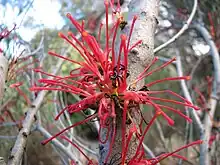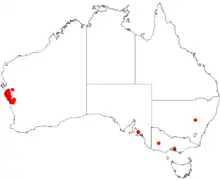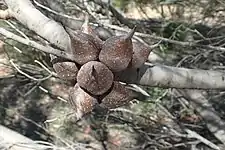Hakea orthorrhyncha
Hakea orthorrhyncha, commonly known as bird beak hakea,[3] is a shrub which is endemic to the Murchison River area of Western Australia.
| Bird beak hakea | |
|---|---|
 | |
| Hakea orthorrhyncha flower Maranoa Gardens Balwyn, Victoria | |
| Scientific classification | |
| Kingdom: | Plantae |
| Clade: | Tracheophytes |
| Clade: | Angiosperms |
| Clade: | Eudicots |
| Order: | Proteales |
| Family: | Proteaceae |
| Genus: | Hakea |
| Species: | H. orthorrhyncha |
| Binomial name | |
| Hakea orthorrhyncha | |
 | |
| Occurrence data from AVH | |

Description
Hakea orthorrhyncha has a spreading habit, growing to between 1–3 m (3–10 ft) tall with a similar spread. The bright red flowers appear in axillary clusters in the leaf nodes on older growth along the branches from early winter to early spring. Leaves vary, they may be needle-like or flat and sometimes forked, curved or straight ending in a sharp point between 7–18 cm (3–7 in) long. Smooth woody fruit are either egg-shaped or elliptic 4–5 cm (2–2 in) long and 2 cm (0.8 in) wide.[4][5][6][7]
Taxonomy and naming
The species was first described in 1868 by botanist Ferdinand von Mueller who gave it the specific epithet orthorrhyncha which is derived from the Greek orthos "straight" and rhynchos "beak"[8] alluding to the straight beak on the seed capsules.[3] The common name, bird beak hakea, is presumed to be a confusion between the Greek words for straight and bird.[9]
There are two varieties of the species, based on differing foliage characteristics:
- Hakea orthorrhyncha var. filiformis F.Muell. ex Benth. has a spreading rounded growth habit to 3 m (10 ft) high, finely textured needle-like dark green leaves often divided up to 160 mm (6 in) long with a groove on the underside of the leaf.[10] This variety grows in the Murchison River to Mingenew area.[9]
- Hakea orthorrhyncha F.Muell. var. orthorrhyncha rounded shrub to 1.5 m (5 ft) has flat long and narrow leathery leaves 2–3 mm (0.08–0.1 in) wide and 140 mm (6 in) long.[10] This variety is confined to the northern sandplains of the Kalbarri region.[9]
Distribution and habitat
Hakea orthorrhyncha grows on the Geraldton sand plains on grey sand, loam and granite.[6]
References
- Barker, R.; Gibson, N.; Barker, W. (2020). "Hakea orthorrhyncha". IUCN Red List of Threatened Species. 2020: e.T117511615A121862290. doi:10.2305/IUCN.UK.2020-3.RLTS.T117511615A121862290.en. Retrieved 13 March 2023.
- "Hakea orthorrhyncha". Australian Plant Name Index (APNI), IBIS database. Centre for Plant Biodiversity Research, Australian Government, Canberra. Retrieved 2009-04-02.
- "Hakea orthorrhyncha". Australian Plant Society (Australia). APS. Retrieved 24 October 2019.
- Wilson, Annette, ed. (1999). Flora of Australia (Volume 17B) (PDF). Canberra: ABRS. pp. 111–112. Retrieved 31 October 2019.
- Holliday, Ivan (2005). Hakeas:A Field and Garden Guide. Reed New Holland. ISBN 1-877069-14-0.
- "Hakea orthorrhyncha". FloraBase. Western Australian Government Department of Biodiversity, Conservation and Attractions.
- "Hakea orthorrhyncha". Australian Native Plants Society (Australia). Retrieved 28 December 2018.
- Francis Aubie Sharr (2019). Western Australian Plant Names and their Meanings. Kardinya, Western Australia: Four Gables Press. p. 267. ISBN 9780958034180.
- "Hakea orthorrhyncha". Flora of South Australia. South Australian Government.
- Young, J A. Hakeas of Western Australia:A Field and Identification Guide. J A Young. ISBN 0-9585778-2-X.
